Papers by Alexander Vikhansky
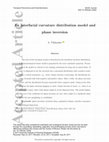
AIChE Journal
The state of the two‐phase system is described by the interfacial curvature distribution. A pheno... more The state of the two‐phase system is described by the interfacial curvature distribution. A phenomenological closure model is proposed for the exact (unclosed) equations. Parameters of the model are related to the existing correlations for drop size in stirred flows. If water is dispersed in oil, the curvature has a uni‐modal distribution with a positive mode. When a control parameter, e.g., water volume fraction is increasing, the distribution becomes bi‐modal with both negative and positive values. After a while, the phase inversion occurs, and the distribution becomes uni‐modal with a negative mode. Going in the other direction the phase inversion happens at lower volume fraction of water, i.e., there is an ambivalent region, where both phases might be in the dispersed state. The model implies, that even if the conditions for phase inversion are met, there might be a significant delay before the new morphology is established.
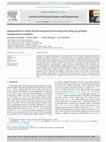
In this paper, a transient model that describes the heat transfer processes in the wellbore durin... more In this paper, a transient model that describes the heat transfer processes in the wellbore during circulation is presented. A simulation of the transient effect on these heat transfer processes was achieved by using a numerical approach to solve the thermal balance equations that describe the heat flow in that system. The present model can be applied for both laminar and turbulent flow regimes through the convective heat transfer coefficient (CHTC). The run time of the present model is relatively short, hence it can be applied for real-time simulation applications. This was achieved by simplifying the model and reducing the calculation complexity. Moreover, the present model has gone through different validation processes. First, the present model is reduced to a steady state condition and solved analytically. This solution was used as a reference to verify the results of the numerical model. Additionally, a grid sensitivity analysis was performed. Second, the analytical solution w...

Chemical Engineering Science, 2021
Abstract A model of droplet breakup during formation of a dense emulsion in a turbulent flow is d... more Abstract A model of droplet breakup during formation of a dense emulsion in a turbulent flow is developed. Droplet fluctuation velocities, eventually causing breakup, are determined using the kinetic theory of granular media. For model validation, an experimental Couette device is employed. The dispersed and continuous phases are deionized water and mineral oil, respectively. Droplet coalescence is suppressed by a surfactant. A series of experiments is conducted for different Couette device rotation speeds and water holdups. For identification of the major droplet breakup model parameter, the critical Weber number, droplet dispersion in the Couette device is modelled by the CFD-population balance A-MuSiG method implemented into the developer’s version of the Simcenter STAR-CCM+® commercial code. A good agreement between the computational and experimental data is obtained for the dispersed phase holdups in the range of 10-30%, commonly encountered in production logging of oil and water producing wells.
Chemical Engineering Science, 2020
This is a PDF file of an article that has undergone enhancements after acceptance, such as the ad... more This is a PDF file of an article that has undergone enhancements after acceptance, such as the addition of a cover page and metadata, and formatting for readability, but it is not yet the definitive version of record. This version will undergo additional copyediting, typesetting and review before it is published in its final form, but we are providing this version to give early visibility of the article. Please note that, during the production process, errors may be discovered which could affect the content, and all legal disclaimers that apply to the journal pertain.
Chemical Engineering Research and Design, 2011
This article describes a numerical approach, which allows for the analysis of the residence time ... more This article describes a numerical approach, which allows for the analysis of the residence time distribution (RTD) in microchannels. While the traditional methods provide the RTD at the outlet of the reactor, we consider the distribution of the tracer's age across the entire flowfield. The equation for the tracer's age distribution is solved by a modified method of moments and the distribution function is calculated by a reconstruction procedure. As an example we consider a Dean vortex-based micromixer.
Journal of Petroleum Science and Engineering, 2021
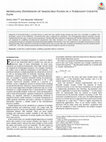
The Canadian Journal of Chemical Engineering, 2018
Dispersion of immiscible fluids in a Couette device, in which the inner cylinder rotates whereas ... more Dispersion of immiscible fluids in a Couette device, in which the inner cylinder rotates whereas the outer one is immobile, is modelled. The developer's version of the STARCCMþ commercial CFD code is employed for simulations. The CFD-population balance technique, recently implemented into the code, is a basis for the computations. The Reynolds stress turbulence model along with the Daly and Harlow transport model are employed for modelling two-dimensional axisymmetric flow field. Formation of a stable emulsion (no coalescence) is considered. Computational results are compared with experimental data available in the literature. A low-rate coalescence is formally introduced for accurately fitting these data. Effects of both the Couette device height and the inner to outer radius ratio on droplet size distributions are also studied using the STAR-CCMþ CFD code. Different physical phenomena influencing the dispersion process are discussed.
Physical Review E, 2000
We considered a flow of a cohesionless granular material in a partially filled three-dimensional ... more We considered a flow of a cohesionless granular material in a partially filled three-dimensional rotating container. A model is suggested to describe a density of the surface flow and the profile of the free surface of the granular material. It is shown that when the container has an ellipsoidal shape the obtained system of partial differential equations can be reduced to a set of two ordinary differential equations.
Physica A: Statistical Mechanics and its Applications, 1998
Two variational closure models are proposed in order to describe stress distribution and arch for... more Two variational closure models are proposed in order to describe stress distribution and arch formation in sandpiles located on a rigid base. The maximum strength and the maximum entropy closures are shown to yield the normal stress minimum below the pile apex. Stress distributions in sandpiles are determined numerically. The force uctuations in a model regular granular assembly are studied by Monte Carlo simulation method. A dependence of the level of the uctuations vs. the macroscopic stress state is determined.
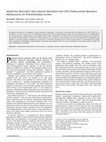
The Canadian Journal of Chemical Engineering, 2015
An adaptive discretisation for population balance equations is presented. The method is combined ... more An adaptive discretisation for population balance equations is presented. The method is combined with the multiphase CFD code STAR-CCM+ of CD-adapco. In order to account for the multidisperse nature of the flow the dispersed phase is split into M size groups; from the modelling point of view each group is a separate phase in every aspect but the name. The groups move with their own velocities and exchange mass, momentum, and energy with other groups and with the continuous phase. Size of a group is not prescribed a priori, but calculated from an additional scalar equation. A special procedure is designed to ensure that at each point all groups have the same volume fractions. As the particle sizes change due to coagulation and breakup, the discretisation of the phase space adjusts itself to the new size distribution. Few groups suffice to predict the mean characteristics of the flow.
Physics of Fluids, 2004
We propose numerical methods for the estimation of the yield of reaction in laminar flows. The me... more We propose numerical methods for the estimation of the yield of reaction in laminar flows. The methods are based on backward tracking of tracer particles. In the case of fast reaction (high Damköhler number) the degree of mixing at a particular point can be calculated by a backward random-walk Monte Carlo simulation. This procedure is applicable for both chaotic and nonchaotic regions. In a chaotic flow the reaction-diffusion equation can be approximated by a one-dimensional equation in Lagrangian coordinates along the stable manifold of a fluid element. An adaptive tracking technique of the stable manifold allows the numerical quantification of the effect of the flow on a finite rate chemistry.
Physics of Fluids, 2009
ABSTRACT We consider the effect of yield stress on the Rayleigh-Bénard convection of a viscoplast... more ABSTRACT We consider the effect of yield stress on the Rayleigh-Bénard convection of a viscoplastic material. First we consider the model problem of convection in a differentially heated loop, which is described by the (modified) Lorenz equations. The presence of the yield stress significantly alters the dynamics of the system. In particular, the chaotic motion can stop suddenly (sometimes, after a period of chaotic oscillations). Guided by the model equations we performed direct numerical simulations of convection of the Bingham liquid in a square cavity heated from bellow. Our interest has been concentrated on the situation when both buoyancy and plastic forces are large. The obtained results are in a reasonable agreement with the predictions by the Lorenz equations.

Physics of Fluids, 2014
ABSTRACT This article describes a generalization of the method of moments, called extended method... more ABSTRACT This article describes a generalization of the method of moments, called extended method of moments (EMM), for dispersion in periodic structures composed of impermeable or permeable porous inclusions. Prescribing pre-computed steady state velocity field in a single periodic cell, the EMM sequentially solves specific linear stationary advection-diffusion equations and restores any-order moments of the resident time distribution or the averaged concentration distribution. Like the pioneering Brenner's method, the EMM recovers mean seepage velocity and Taylor dispersion coefficient as the first two terms of the perturbative expansion. We consider two types of dispersion: spatial dispersion, i.e., spread of initially narrow pulse of concentration, and temporal dispersion, where different portions of the solute have different residence times inside the system. While the first (mean velocity) and the second (Taylor dispersion coefficient) moments coincide for both problems, the higher moments are different. Our perturbative approach allows to link them through simple analytical expressions. Although the relative importance of the higher moments decays downstream, they manifest the non-Gaussian behaviour of the breakthrough curves, especially if the solute can diffuse into less porous phase. The EMM quantifies two principal effects of bi-modality, as the appearance of sharp peaks and elongated tails of the distributions. In addition, the moments can be used for the numerical reconstruction of the corresponding distribution, avoiding time-consuming computations of solute transition through heterogeneous media. As illustration, solutions for Taylor dispersion, skewness, and kurtosis in Poiseuille flow and open/impermeable stratified systems, both in rectangular and cylindrical channels, power-law duct flows, shallow channels, and Darcy flow in parallel porous layers are obtained in closed analytical form for the entire range of Péclet numbers. The high-order moments and reconstructed profiles are compared to their predictions from the advection-diffusion equation for averaged concentration, based on the same averaged seepage velocity and Taylor dispersion coefficient. In parallel, we construct Lattice-Boltzmann equation (LBE) two-relaxation-times scheme to simulate transport of a passive scalar directly in heterogeneous media specified by discontinuous porosity distribution. We focus our numerical analysis and assessment on (i) truncation corrections, because of their impact on the moments, (ii) stability, since we show that stable Darcy velocity amplitude reduces with the porosity, and (iii) interface accuracy which is found to play the crucial role. The task is twofold: the LBE supports the EMM predictions, while the EMM provides non-trivial benchmarks for the numerical schemes.
Physica A: Statistical Mechanics and its Applications, 2002
We considered a ow of a cohesionless granular material in a partially ÿlled three-dimensional rot... more We considered a ow of a cohesionless granular material in a partially ÿlled three-dimensional rotating container. A variational continuum mechanics model is suggested to describe the proÿle of the free surface of the granular material. A combination of a level set method and a variational form of energy conservation equation allows us to describe ow of granular material in arbitrary-shaped containers.
Microfluidics and Nanofluidics, 2008
We consider the axial dispersion of a liquid flowing through a micro-channel, which has a slender... more We consider the axial dispersion of a liquid flowing through a micro-channel, which has a slender shallow cross-section. A lubrication approximation allows for an analytical analysis of the effect of cross-section and aspect ratio on the dispersion process. Numerical simulations are performed in order to verify the approximate solution. Keywords Taylor dispersion Á Micro-flows Á RTD Á Lubrication approximation 2 The equations for age distribution Consider an incompressible liquid with viscosity l driven by a pressure gradient p z through a straight channel with
Journal of Non-Newtonian Fluid Mechanics, 2008
In the present study we propose a new version of the lattice-Boltzmann (LB) method for the simula... more In the present study we propose a new version of the lattice-Boltzmann (LB) method for the simulation of flow of yield-stress liquids. Unlike traditional LB methods, collisions are treated implicitly, i.e., the collision term is chosen in such a way that the stress and strain rate tensors satisfy the constitutive equation after the collision. This approach requires the solution of a (one-dimensional) non-linear algebraic equation at each point and at each time step. In the practically important cases of a Bingham liquid this equation can be solved analytically. We calculated the flow of Bingham fluid through a channel and periodic mesh of cylinders.
Journal of Non-Newtonian Fluid Mechanics, 2010
The problem of initiation of thermal convection in rectangular cavities filled with viscoplastic ... more The problem of initiation of thermal convection in rectangular cavities filled with viscoplastic material is considered. A two-sided asymptotic expansion is combined with numerical modelling in order to obtain an expression for the critical yield number, which is valid for the entire range of the cavity's aspect ratio.
Journal of Computational Physics, 2003
In this study we consider a combination of an interpolation technique with the DÕAlambert princip... more In this study we consider a combination of an interpolation technique with the DÕAlambert principle that allows the direct numerical simulation of fluid-solid flows on a regular rectangular grid. The method models a no-slip boundary with the second-order accuracy interpolation scheme without explicit calculation of the forces that the particles exert at the fluid. The method is applicable for a wide range of Reynolds numbers from creeping flows up to Re % 100:
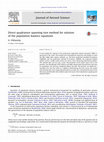
Journal of Aerosol Science, 2013
A new method for solution of the multivariate population balance equations (PBEs) is presented in... more A new method for solution of the multivariate population balance equations (PBEs) is presented in this work. The method uses M quadrature abscissas and weights to close the PBE. Unlike other similar methods, e.g., the direct quadrature method of moments (DQMoM) and the quadrature method of moments (QMoM), the proposed method neither inverts a badly scaled matrix nor solve a time-consuming eigenvalue problem. The method does not use any a priori discretization of the phase space and as the particles' size distribution (PSD) widens and shifts toward large characteristic sizes due to coagulation, the abscissas adaptively follow the PSD. The particles are linked by a spanning tree; the tree works as a pipeline redistributing the mass across the system and ensuring that each computational particle accounts for a prescribed fraction of the total mass and therefore the method is given the name: direct quadrature spanning tree method (DQST).










Uploads
Papers by Alexander Vikhansky